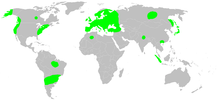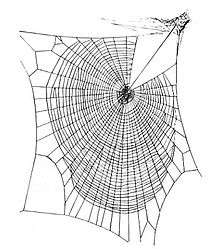Zygiella x-notata
Zygiella x-notata, sometimes known as the missing sector orb weaver or the silver-sided sector spider,[1] is a spider in the family Araneidae.
| Zygiella x-notata | |
|---|---|
 | |
| Scientific classification | |
| Kingdom: | Animalia |
| Phylum: | Arthropoda |
| Subphylum: | Chelicerata |
| Class: | Arachnida |
| Order: | Araneae |
| Infraorder: | Araneomorphae |
| Family: | Araneidae |
| Genus: | Zygiella |
| Species: | Z. x-notata |
| Binomial name | |
| Zygiella x-notata (Clerck, 1757) | |
 | |

Description
Zygiella x-notata females are up to 11mm in size, males up to 7mm. The prosoma is yellow-brown, with a leaf-like mark on the opisthosoma. The abdomen has a silvery sheen due to guanine crystals below the skin.[2] In moderate climate, adults appear from July to October, sometimes even into December. In warmer regions, they are active all year.
This spider builds its web mostly into window frames, but can also be found on walls, fences, or under the bark of old trees. It is very common around boats and docks throughout the world.
Web
Adult spiders build an orb-web usually with two sectors without connecting threads in one of the two upper corners. The signalling thread in the middle of these sectors leads to the spider's retreat. In the evening and at night, however, the spider sits in the center of the web. It renews the web in the morning hours.
A normal web consists of about 25 to 30 radial threads. Young spiders, and sometimes adults, build webs without the free sectors, especially if the angle between signalling thread and radii gets too big (at angles above 40 degrees).[2]
Feeding behavior
Catching prey is instinctive in Zygiella in which it differs from other Araneidae, who have to learn this behavior. When alerted by movements of caught prey, the spider moves along the signalling thread into the web center, to orient itself. The killed and wrapped prey is moved to the hideout.
Reproduction
Females and males can often be seen together in one nest. Males with better web-building ability are more attractive to females. Before mating, the male plucks and drums on a special thread attached to the web of the female. The eggs overwinter in a cocoon, the spiderlings hatch next spring.
Distribution and subspecies
- Zygiella x-notata (Clerck, 1757) — Holarctic, Neotropical
- Zygiella x-notata chelata (Franganillo, 1909) — Portugal
- Zygiella x-notata percechelata (Franganillo, 1909) — Portugal
See also
References
- "Spider News: Messy Webs and Tarantula Hearts". Science 2.0. 12 July 2011. Retrieved 22 November 2012.
- Factsheet 6: Missing-sector Orbweaver (Zygiella x-notata), British Arachnological Society, 2016. Retrieved 27 November 2016
- Le Guelte, Louis: Structure de la toile de Zygiella x-notata Cl. 1966.
- Levi, Herbert Walter: "The orb-weaver genus Zygiella (Araneae, Araneidae)." in Bulletin of the Museum of Comparative Zoology, vol. 146, no. 5, Cambridge 1974. ISSN 0027-4100
- Weissmann, Monika: Web-building and prey-capture in two orb-weavers. 1987.
External links
| Wikimedia Commons has media related to Zygiella x-notata. |